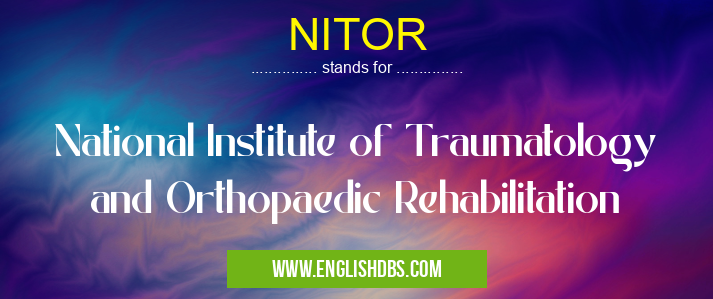What does NITOR mean in ORTHOPAEDIC
The National Institute of Traumatology and Orthopaedic Rehabilitation (NITOR) is a research institution that focuses on the treatment of bone and joint injuries, as well as rehabilitation strategies for individuals who have suffered musculoskeletal trauma. NITOR works to combine recent advances in orthopaedics and biomechanics with modern rehabilitation techniques to develop effective treatment plans for patients.

NITOR meaning in Orthopaedic in Medical
NITOR mostly used in an acronym Orthopaedic in Category Medical that means National Institute of Traumatology and Orthopaedic Rehabilitation
Shorthand: NITOR,
Full Form: National Institute of Traumatology and Orthopaedic Rehabilitation
For more information of "National Institute of Traumatology and Orthopaedic Rehabilitation", see the section below.
» Medical » Orthopaedic
Essential Questions and Answers on National Institute of Traumatology and Orthopaedic Rehabilitation in "MEDICAL»ORTHOPAEDIC"
What does NITOR stand for?
NITOR stands for the National Institute of Traumatology and Orthopaedic Rehabilitation.
What types of research does NITOR conduct?
NITOR conducts research related to the treatment of bone and joint injuries, as well as rehabilitation strategies for individuals who have suffered musculoskeletal trauma. This includes research about advances in orthopaedics and biomechanics, combined with modern rehabilitation techniques.
Who benefits from NITOR's research?
Patients benefit from the findings of NITOR's research by receiving effective treatments for their musculoskeletal injuries or traumas. Additionally, doctors, clinicians, physical therapists, and other medical professionals can apply the latest insights gained from NITOR's research in their own practice.
Final Words:
By combining recent advances in orthopaedics and biomechanical principles with rehabilition techniques, the National Institute of Traumatology and Orthopaedic Rehabilitation (NITOR) works to develop treatments that are tailored to an individual patient's needs. Through its work, both patients and medical practitioners benefit by having access to up-to-date information resources regarding musculoskeletal injury prevention and management protocols.
